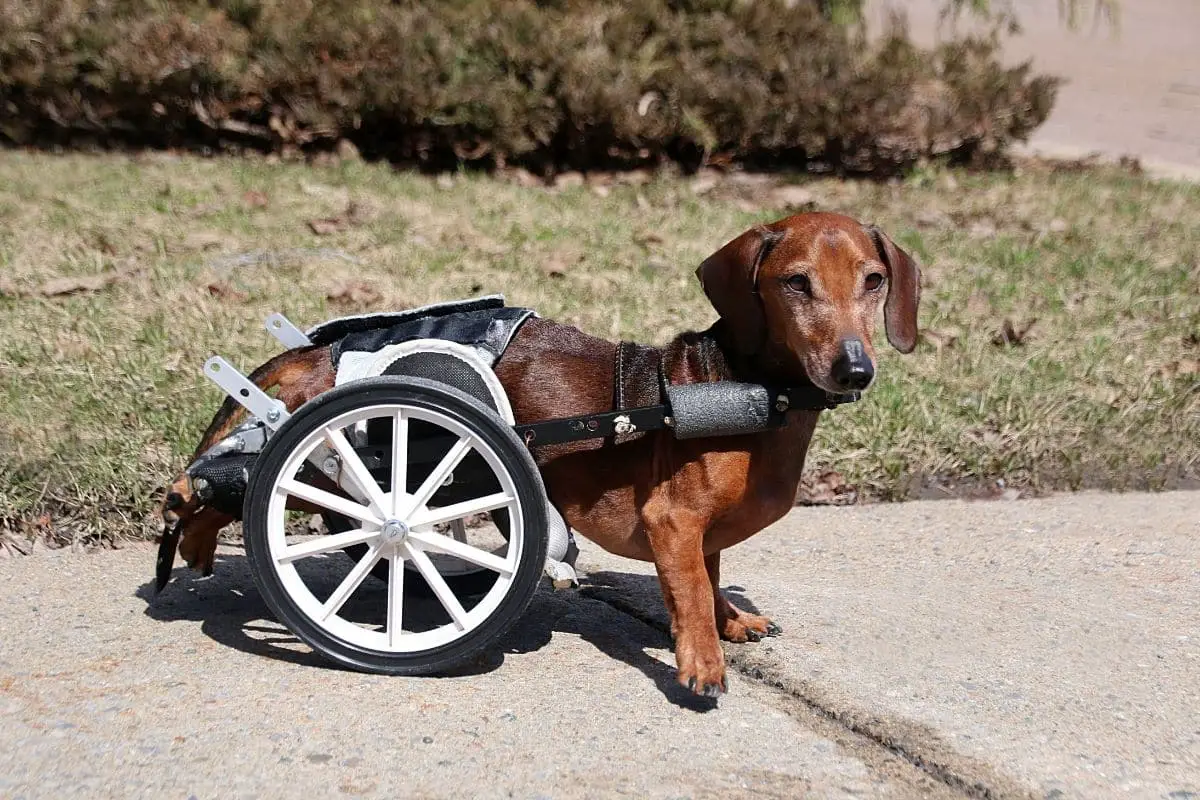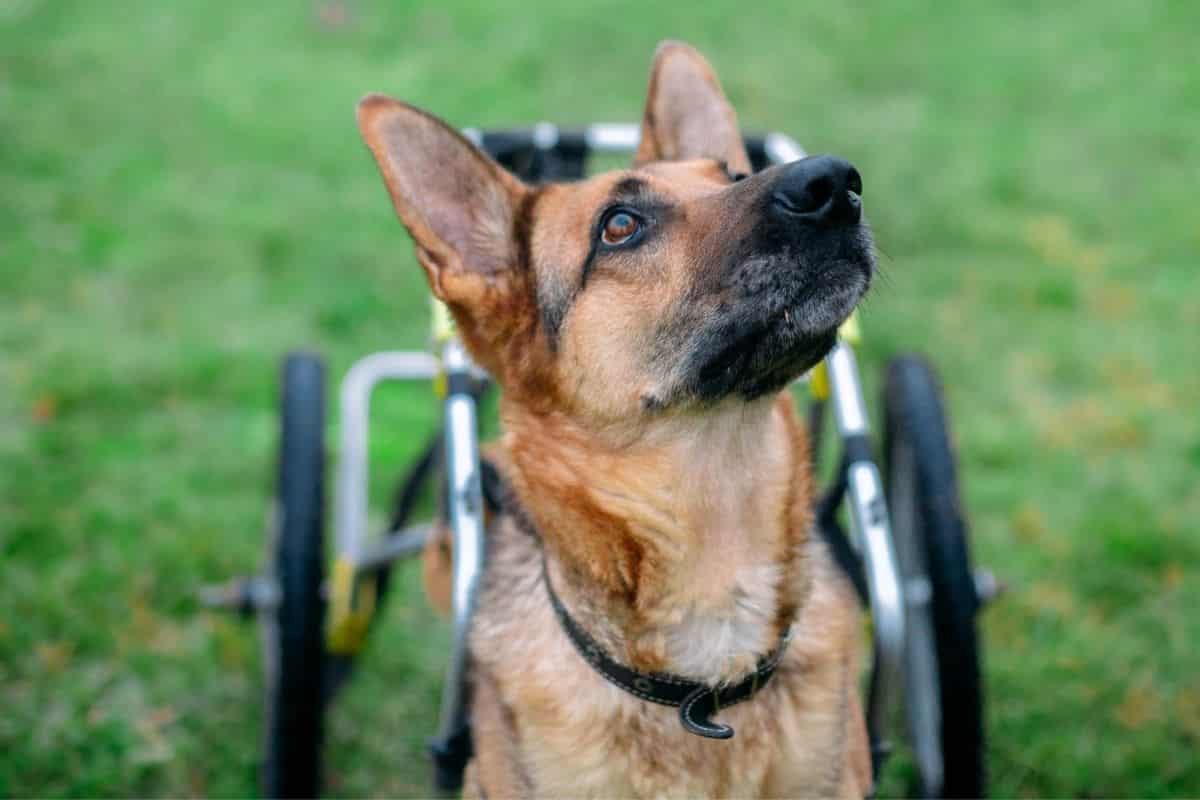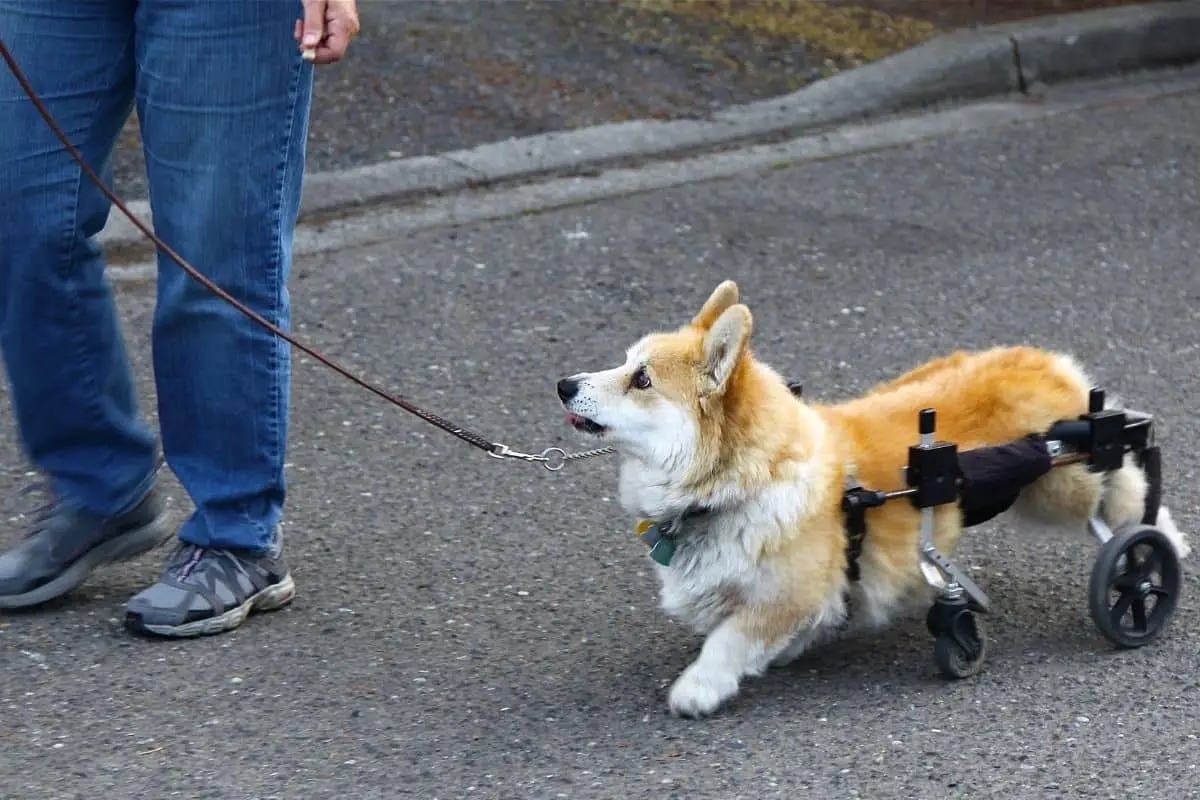Most pet owners aren’t aware of the more unusual dog diseases, although they can often be the most dangerous.
Genetic diseases in dogs, such as degenerative myelopathy, typically don’t start off with painful symptoms.
Degenerative myelopathy in canines is a quiet and creeping disease which has seen very few clinical trials.
It may start with your dog walking in a different way, or he may drag his feet. The early onset of signs is very subtle, and pet owners need to be observant to spot them.

In this article, we take a look at what degenerative canine myelopathy is and how it shows in your dog.
We will also explore possible treatment strategies and ways you can help your dog to feel comfortable during the time when he suffers most.
What Is Degenerative Myelopathy (DM) In Dogs?
Degenerative myelopathy is a progressive, degenerative disease of the spinal cord that affects dogs and cats.
DM is also known as canine degenerative myelopathy or degenerative radiculomyelopathy.
This disease slowly breaks down the protective coat of the spinal cord. This results in the breaking down of the white particles of the spine attacking the dog’s nervous system.
The nervous system controls the dog’s movements. The more the disease breaks down the white matter, the less information can travel from the dog’s brain to the legs.
This leaves the dog without sensation in their limbs, and it will be unable to control its legs and other body parts.
It is most commonly seen in middle-aged to older dogs, with an average age at diagnosis of 7 years. However, on rare occasions, DM can also be diagnosed in younger dogs.
The clinical signs are similar to those seen in humans with Lou Gehrig’s disease or amyotrophic lateral sclerosis (ALS), including muscle weakness, loss of coordination, difficulty walking or standing.
This will lead to paralysis and organ failure over time. Degenerative radiculomyelopathy shortens the dog’s life expectancy significantly, and commonly dogs die from this disease within 3 years.
Some dogs may live longer, while other affected dogs die within a year. This depends on when the disease was diagnosed and how fast it advances.
DM may be diagnosed by physical examination alone, but additional diagnostic tests such as MRI, EMG/NCS, CSF analysis, and blood work will help confirm the diagnosis.
Research About Canine Myelopathy
There has been some research into the cause of degenerative myelopathy in dogs.
However, researchers have initially found that certain breeds are more likely to develop DM than others. Originally, vets believed this disease to be a condition exclusively in German shepherds.
For this reason, it was also called German Shepherd Degenerative Myelopathy for a long time.
New research and other cases have shown that this disease does not only occur in German shepherds but also in other large dog breeds.
Scientists have observed that the symptoms from DM are very similar to that of human sufferers with Lou Gehrig’s disease, and this has become the main research approach.
Researchers try to identify symptoms and disease details of patients with ALS, and apply similar treatment methods to the canine affected by this ALS-like illness.
In addition, it appears that genetic predisposition plays a role in the development of DM. In a study in 20009, researchers found that the gene SOD1 is involved in the development of DM.
This has resulted in the creation of a DNA test for dogs to check if they have degenerative myelopathy.
Causes Of Degenerative Myelopathy In Dogs
Although there is no exact cause which has been identified for degenerative myelopathy, scientists suspect a genetic mutation with the SOD-1 gene to be the main factor.
Veterinarians can check if a dog has DM by doing a DNA test. The genetic testing can clarify if a dog is:
- at high risk of degenerative myelopathy (with two abnormal SOD-1 genes)
- a carrier of the disease (with one normal gene and one abnormal gene)
- not at risk (with two normal SOD-1 genes)
Although DNA can provide more clarity for pet owners, there are reports of exceptions where dogs have two abnormal genes and the disease did not break out.
These dogs may or may not develop DM in the future. However, as a pet owner, it is important to be aware of the potential risks.
At What Age Does Degenerative Myelopathy Occur?
The age of onset for DM varies greatly between individual dogs. Some dogs develop DM after 5 years, while others do so much later in their lives.
The most common age range of dogs with degenerative myelopathy is between 5 and 14 years. However, there have been rare reports of dogs under 4 with clinical signs of this disease.
What Breeds Are Most Affected By Degenerative Myelopathy?
Several larger dog breeds are most prone to degenerative myelopathy.
These include:
- Boxer
- Golden retriever
- Borzoi
- German shepherd
- Cardigan Welsh corgi
- Bernese mountain dogs
Neurologic examination and DNA testing may help to identify whether dogs have this fatal disease.
While not every dog will have a mutation of their SOD1 gene, the above-mentioned breeds have been identified as more likely to have the disease.
Clinical Symptoms Of Canine Myelopathy
Symptoms of degenerative myelitis vary widely among different dogs. Some early symptoms may indicate that your dog has DM.
Early symptoms of this disease start in the hind limbs and around the back of the dog.
The dog may have wobbly legs and may struggle to get up. As the dog tries to balance the weakness in its hind legs, it may start to sway its hips when walking.
As the weakness in their limbs, particularly the hind legs, worsens over time, you may notice that your dog is dragging its feet.
After a while, the dog will lose more of its leg muscles, and spasms in the back legs start to set in.
As the disease progresses, your dog will lose all sensation and control over its hind legs, and the animal will become paralyzed.
In the advanced stages of degenerative myelopathy, the early-stage symptoms will now move to the front legs.
In addition to this, the dog can develop other serious illnesses such as pneumonia and infections. It won’t be able to control its bowels. This leads to fecal incontinence, as well as urinary incontinence.
The muscle loss will spread across the dog’s entire body. It will struggle to breathe and cannot swallow its food anymore.
In the end, this will impact its inner organs, resulting in organ failure and death.
It has been reported that most dogs that have been diagnosed with canine degenerative myelopathy reach the stage of paralysis one year after the outbreak of the disease.
The more advanced symptoms will show after one year and will last until the dog’s death. A dog with DM usually dies 3 to 5 years from the onset of its symptoms.
If you think your pet might have degenerative myelopathy (DM), make sure to contact your veterinarian immediately.
Is Canine Degenerative Myelopathy Painful For My Dog?
Initially, the early signs of DM look very similar to that of a ruptured disc, spine infection, or hip dysplasia. Unlike these painful diseases, canine myelopathy is not painful for your dog in the early stages.
While some dogs may experience an uncomfortable twinge in their spine as the nerves start to die, your dog will only start to bite their paws and not display any other signs that it is in pain.
If you notice that your dog starts to chew its paws, you can try to put soft dog boots on its paws to ensure it doesn’t injure itself.
If you notice any of the signs and symptoms we mentioned, it’s important to get the opinion of your vet. He will be able to take tests and make a clear diagnosis.
How Is Degenerative Myelopathy Diagnosed?
First, your veterinarian will look at your dog’s symptoms, and he will then try to rule out other conditions. Here are some of the ways how your vet may be able to diagnose canine myelopathy.
Physical Examination And Symptoms
Your veterinarian will look at how your dog moves and walks. They will also examine if your dog has any problems controlling his/her bladder or bowel movements.
You should let your vet know about any unusual behaviors you have noticed in your dog. Even the smallest detail may help to exclude other disorders.
The Dog’s History
Similar to human patients, the veterinarian also takes into account any of the dog’s previous illnesses.
As generative myelopathy is a mainly genetic disease, it’s also important to check if the dog’s parents were carriers of the disease or whether they had symptoms of DM.
Neurological Tests
A diagnosis of degenerative myelopathy requires an accurate neurological exam.
Your vet will perform blood tests to check for abnormalities in the levels of proteins called globulin. If these levels rise, then they could indicate a problem.
A spinal tap may be needed to collect fluid from the spine. This test will allow your vet to see if there is inflammation or infection in the spinal cord.
When a veterinarian suspects that your dog might have DM, he will refer your dog to a veterinary neurologist, who will perform an MRI scan on the spinal cord.
These detailed images show the different layers of the spine and this can help to spot any abnormalities and rule out any other diseases.
The veterinary neurologist will examine the dog to see if it shows any signs of weakness, and he will check whether there are any changes in the nerve cells in the spinal cord.
This will help them determine what type of degeneration is taking place in the spinal cord. The results of the test will also indicate how far along the disease process is.
However, a clear diagnosis of degenerative myelopathy can only be reached by checking the spinal cord after the dog’s death.
DNA Testing
As clinical signs of degenerative radiculomyelopathy aren’t always easy to identify, your vet will likely also order a DNA test for your dog.
As mentioned, degenerative myelopathy is suspected to be caused by a genetic mutation, and a specifically developed DNA test can confirm if your dog is at risk of this disease.
In addition, a DNA test can detect carriers of the disorder, which means that your pet may pass down the gene to future generations.
Dog DNA tests are relatively inexpensive and you can order them on the website of the Orthopedic Foundation For Animals.
The test gets delivered to your home where you can do the test with your dog yourself. You simply swab the inside of your dog’s cheek with the pads provided, and then securely mail it back to OFA.
They will analyze the DNA sample and advise you and your vet if your dog has the faulty gene.
However, the genetic test will only be able to tell you if your dog has the mutated SOD-1 gene which puts your dog at risk.
It will not be able to tell you if your dog suffers from an active outbreak of degenerative myelopathy.
There are three possible test results your dog may receive after a DNA test for degenerative canine myelopathy.
Normal (N/N)
When your dog received a test result as normal, then your dog has two healthy, normal SOD-1 genes.
No genetic abnormalities have been found for this gene, and your dog is very unlikely to develop any DM symptoms.
However, there are reports of cases that had a normal set of genes, and the dogs still developed DM.
This hints that there may also be some other risk factors, which may be specific to certain breeds.
Carrier (C/N)
If your dog received a C/N carrier test result, then your dog has one normal and one mutated gene. Dogs as carriers for degenerative myelopathy will likely not develop any symptoms.
However, there is a possibility that the disease could break out, so pet owners should observe their dog and any changes of behavior very closely.
At-Risk (A/A)
A dog with an A/A test result is at risk of developing canine myelopathy. Dogs in this category have two mutated SOD-1 genes which could lead to DM.
If your dog is already showing symptoms that may indicate a generative myelopathy diagnosis, then this test result may confirm this.
If your dog doesn’t show any symptoms and it has received the A/A result, it may never develop any DM symptoms.
There is no definitive diagnosis for degenerative canine myelopathy. Not all dogs with a DNA test result of A/A will have degenerative radiculomyelopathy in their lifetime.
As a dog owner, it is however good to be aware of the possible risks.
Treatment Of Degenerative Myelopathy In Dogs
Unfortunately, there is no known cure or treatment for DM at the moment. There are still further studies ongoing to develop medication to slow down the disease progression.
At the moment, the disease will run through the different stages we mentioned above, and lead to the dog’s passing.

With this poor prognosis, vets and pet owners cannot stop the disease but they can manage the worsening symptoms, giving the suffering dog a reasonably good quality of life.
Some vets recommend euthanasia for dogs who suffer from severe symptoms such as paralysis and loss of bladder control. Other vets prefer to treat the symptoms until the end.
In either case, it is important to make sure that your dog receives regular veterinary care.
The most common treatments include painkillers, anti-inflammatory drugs, muscle relaxants, and antibiotics.
In addition, special diets and exercise regimes may help improve the condition of your dog.
It is recommended that your dog undergoes regular blood tests to monitor its health and check for any potential complications.
Your vet will also advise you on how best to cope with your dog’s illness and what measures you need to take to keep it comfortable.
He may also suggest any rehab or alternative therapy options to ease the symptoms of your dog.
Hydrotherapy
Hydrotherapy involves using water to stimulate the body by immersing it in cold or warm water. This helps reduce inflammation and increase circulation in your dog’s body. It is often used during rehabilitation after surgery or injury.
Pets can benefit from hydrotherapy because it allows them to move around freely without having to worry about falling over. It also reduces stress levels and improves mood in your animal.
Pets can use hydrotherapy to recover from injuries, arthritis. They can also use it to reduce inflammation and speed up recovery from surgery.
It is also used in life-long conditions such as degenerative myelopathy.
This type of therapy is usually done in a swimming pool or spa. Most dogs love water, and they will enjoy it even more because they will not be burdened by their weight.
Hydrotherapy is often offered as part of a canine rehabilitation program. As a pet owner, a canine rehab specialist will likely look after your pet during the swimming sessions.
Some rehab programs for dogs also provide underwater treadmills to ensure the dog’s core stays strong and its leg muscles are flexible.
Laser Therapy
Another form of therapy for dogs with DM is laser therapy. Laser therapy uses light waves to stimulate cells and tissues.
The light energy stimulates cell metabolism and increases blood flow. It is believed that laser therapy works by stimulating nerve endings, which then send signals to the brain.
When the brain receives these signals, it tells the rest of the body to work harder.
Together with other rehabilitation therapies, this can lead to an improvement in the overall health of the dog and the slowing down of the symptoms of DM.
However, in the past, veterinarians were reluctant to recommend laser therapy for dogs with DM because there were no long-term studies to prove that it works.
New studies intend to look at laser therapy and its effects on degenerative myelopathy. This could provide a significant improvement in the dog’s health and give it a healthier, longer life.
Dog Acupuncture
Acupuncture has been practiced for thousands of years in China and Japan. Today, acupuncture is becoming popular among people all over the world.
It is based on the theory that our bodies have many points where tiny needles can be inserted into the skin. These points connect us to the universe and allow us to communicate with each other and with nature.
In traditional Chinese medicine, acupuncture is used to treat a wide range of illnesses, ranging from headaches to cancer. However, it is most commonly used to relieve pain.
In veterinary practice, acupuncture is used to help animals who suffer from chronic pain and discomfort. It can also improve their quality of life.
There are two types of acupuncture: Traditional Chinese Medicine (TCM) and Western Medical Acupuncture. TCM acupuncture involves inserting very fine needles into specific points on the body. The needles are left in place for 30 minutes to one hour.
Western medical acupuncture involves using needles similar to those used in Chinese medicine but instead of being placed directly deep into the skin, they are placed near the surface of the skin.
Both forms of acupuncture are effective treatments for dogs suffering from degenerative myelopathy and other neurological disorders.
Medication
Although there is no treatment option or medication to specifically stop the progress of myelopathy, your vet may prescribe medication to treat the symptoms.
Medication usually used for hip dysplasia and arthritis can provide some relief from the uncomfortable effects of degenerative myelopathy.
These can reduce inflammation and joint stiffness. The specific medication will depend on the symptoms your dog displays
If you suspect that your dog has degenerative myelopathy, he will need regular physical examinations and tests to monitor his progress.
Your vet will probably prescribe medications to control pain and muscle spasms. He may also suggest anti-inflammatory drugs to reduce swelling and inflammation.
He may also advise you about diet changes if your dog suffers from weight loss.
How To Support Your Dog With Canine Degenerative Myelopathy
So, what can you do for your dog to ensure it has a relatively happy, comfortable life living with degenerative canine myelopathy?
Here are some of the main things that you can do to support your dog during this difficult time.
Exercise Your Dog Daily
One thing that many people forget about when dealing with a sick dog is that they must provide daily physical exercise.
This is because even if the dog does not appear to be in pain, he or she might be experiencing discomfort.
You should also make sure that your dog gets plenty of fresh air and sunshine every day. This helps keep him healthy and reduces stress levels.
To make your dog’s walk as comfortable as possible, you may want to get him a support harness that will aid his posture.

If your dog is biting or chewing his paws, you may also want to buy some booties for him. This will stop him from chewing, and it will also protect their paws when walking.
Give Your Dog A Massage
A massage can be an excellent way to relax your dog and ease any tension he or she may be feeling.
It can also help increase circulation and stimulate the lymphatic system which will help clear toxins out of the body.
Massages can be given by yourself or by another person. You can use a towel or blanket as a cushion for your dog to lie on.
Make sure that the area where you give your dog a massage is clean and free from dirt.
Use a small amount of oil such as baby oil or olive oil. Avoid using lotions or creams as these could irritate your dog’s skin.
Use gentle strokes along the spine and legs. Start at the base of the tail and work towards the head. A gentle rub on his muscles helps to stimulate them and ease any stiffness.
Give your dog a gentle massage once a week. If your dog feels uncomfortable after a massage, try giving him or her a few day’s rest before continuing.
You may also want to ask your vet for any particular massage strokes that might relieve your dog’s discomfort.
Express Your Dog’s Bladder
When your dog struggles to get up and go on his usual walk to empty his bladder, then it may become important that you do this.
Expressing a dog’s bladder helps to stop the build-up of bacteria and so avoids urinary tract infections in your dog.
This process is called “expressing the dog’s bladder”. This simply means that you stimulate the dog’s bladder until he relieves himself.
The best way to express your dog’s bladder is to place a plastic bag over his backside. Make sure that the bag is large enough so that it covers both hind legs.
Hold the bag firmly around the dog’s waist and gently squeeze it together. The pressure of the bag against the dog’s backside may already encourage him to urinate.
Also, check out this video on how to express a dog’s bladder. It’ll show you where to place your hands to empty your dog’s bladder.
It’s recommended to express a dog’s bladder at least every 6 hours. However, this depends on your dog and how well he can hold urine.
If your dog is unable to urinate due to pain, then you should take him to see your veterinarian immediately.
It’s also a good idea to check with your vet. He will be able to give you more advice on how to express your pet’s bladder.
A Good Diet
Particularly sick dogs need a balanced diet. Even some of the smaller changes to your dog’s diet can make a big difference.
In 1998, a veterinarian called Dr. Roger Clemmons developed a diet to specifically slow down degenerative myelopathy in dogs.
Aligned with a clear exercise and acupuncture rehab program, this diet consists of fresh whole dog foods, herbs, and supplements.
You can find out more about Dr. Clemmons’ approach to the diet of a dog suffering from DM on his website here.
You can also find a list of the basic diet on his website, together with the specific supplements that Dr. Clemmons suggests.
Normal Weight
Your dog needs to maintain a healthy weight if he is going to stay active for as long as possible.
Weight loss is common when a dog has DM. Particularly in the later stages of the disease, you may notice that your dog seems tired all the time and wants to sleep more than normal.
However, your dog doesn’t have to lose weight if you provide a balanced diet that provides him with all the nutrients he needs.
On the other hand, if your dog is overweight, you should also check with your vet how to help him lose weight.
Overweight dogs are more likely to suffer from other health problems such as arthritis and diabetes.
The less your ill dog moves, the fewer calories he will burn and the risk of these weight-related diseases will increase.
Make sure that you monitor your dog’s weight regularly. You might even want to weigh him once a week.
Range-Of-Motion-Exercises
When your dog suffers from degenerative myelopathy, it becomes increasingly difficult for him to move around. Many owners report that their dog starts to limp or walk like an old man.
To avoid this, you should start range-of-motion exercises. These exercises include stretching and strengthening exercises.
Stretching exercises involve gently moving your dog’s limbs through different positions. For example, you could put your dog into a sitting position and then stand up behind him.
Next, you would gently stretch your dog’s back legs forward. Then, do the same for the front legs.
These stretches will strengthen your dog’s muscles and help them stay more flexible.
Check with your vet first before you do any of these exercises. Your veterinarian will be able to give you more advice on what exercises you could do with your dog, and how best to relieve his pain.
Anti-Slip Surfaces
If your dog has DM, you may notice that he tends to slip on slippery surfaces. This is not comfortable for the dog because it makes him feel insecure.
Getting up for a dog with canine degenerative myelopathy is very difficult without help. A slippery surface also poses the risk that your dog may injure himself further.
This problem can be solved by using anti-slip mats at home and work. They come in various sizes and shapes so that they fit perfectly into your dog’s environment.
You should always keep one mat near your dog’s bed so that he can get out of his dog bed a little easier without slipping.
Keep in mind that some people have reported that their pets were allergic to certain types of anti-slip mats.
If this happens, you can try another type of mat.
Remove Toxins
Toxins build up in the body over time. When a dog has degenerative myelopathy, toxins can accumulate faster than usual.
Therefore, you need to make sure that you only use chemical-free cleaning products.
It is important to regularly clean your home so your dog lives in a clean environment and no further infections can spread.
Therefore, if you have a dog suffering from degenerative myelopathy, you need to make extra effort to keep his house as clean as possible.
Your dog may not be able to pick things up off the floor, but he can still track dirt and germs all over the place.
So, when you clean your house, make sure that you remove the dirt and germs from the floors and other surfaces.
Also, make sure that you wipe down furniture, walls, and doors.
Orthopedic Bed
Similar to arthritis, degenerative canine myelopathy affects muscles and joints, which means lying on a hard surface can be painful for your ill dog.
Therefore, you should consider getting orthopedic beds for your dog. Orthopedic beds provide support for your dog’s spine and prevent him from having pressure points.
They are made of soft foam material and can be easily adjusted to suit your dog’s size.
Make sure that you check the manufacturer’s instructions before buying an orthopedic bed for your dog.
To find the right orthopedic bed for your pet, you can ask your local pet store or check out websites, such as amazon.com, that offer orthopedic dog beds like this Big Barker Orthopedic Dog Bed.
Stress-Free Environment
When you see your dog struggling to walk, you might think that he does not want to move around.
However, dogs with DM often suffer from muscle spasms, which makes moving around very uncomfortable, and sometimes painful.
Therefore, it’s important to be aware of your dog’s comfort level more than normal.
While a little bit of exercise is essential to keep the animal’s muscles flexible, too much exercise can be painful and debilitating for your pet.
Make sure that you don’t push him beyond what he can handle.
Try to reduce stress levels in your dog’s life by providing him with plenty of the right food, water, and a comfortable bed.
Lots Of Love, Care, And Attention
Just like when we humans are ill, your sick dog will also need some special love, care, and attention.
He needs to feel safe and secure, so he doesn’t worry about being left out. Your dog should still feel like part of your family.
You must spend lots of quality time with your pet. Whether this is on your walks, with a massage, or some gentle playtime.
But remember to avoid roughhousing with your dog. This could cause injuries to your pet. Instead, try to play with him gently using toys that are appropriate for his age and condition.
If your dog has been diagnosed with degenerative myelopathy, then you need to take extra precautions to protect him from any kind of injury.
Dog Wheelchair
A wheelchair is one of the most useful tools for people who have difficulty walking due to illness or disability.
The same goes for pets. If your dog suffers from degenerative myelopathy and cannot walk properly, then you can get him a dog wheelchair.
This will allow him to move around without injuring himself. It will also help him stay active and healthy.
The most basic dog wheelchairs are made of two tires and a metal frame with straps, similar to the Walkin’ Wheels Dog Wheelchair.
These wheels are usually placed at the back of the dog’s body and attached to the metal frame.
Some wheelchairs come with handles and other accessories that will make them easier to maneuver.
There are many brands available and some are even specializing in dog mobility care, such as k9carts.com. You can even visit your local pet shop and ask if they sell these wheelchairs.
Dog Trolleys
As an alternative to dog wheelchairs, you may also find dog trolleys. These are specially designed carts that are used to transport small to medium-sized dogs.
They are usually equipped with ramps, soft cushions, and handles. They are very easy to use and maneuver.
Trolleys are great for transporting your dog from place to place. They are also helpful when taking your dog outside.
You can easily carry your dog inside the house or go shopping with him.
Dog Stairs
Another option for getting your dog up and downstairs is a dog stairlift. These lifts are specially designed for dogs.
They are designed to assist your dog in climbing and descending stairs. However, stairlifts do have a weight limit and not all are designed for larger breeds.
You must check the weight limit of any stairlift you may want to purchase.
Dog Ramp
If your dog suffers from degeneration myelopathy, then it’s likely that he won’t be able to climb stairs. But there are other options available to help him navigate a couple of steps or smaller heights.
One of the best solutions is a dog ramp. A dog ramp is a large step that allows your dog to safely access areas where he would otherwise struggle.
Ramps are commonly used to help a dog into a car or to climb over a few things. As dog ramps are relatively short, they are not designed for the dog to climb stairs.
Your vet will be able to recommend a suitable ramp for your dog, or you can check out dog ramps online.
These ramps come in a range of shapes and sizes. Some are a long, flat surface where your dog can walk on, while others can be folded to save space.
Whatever ramp your dog uses, you should always supervise to ensure your dog doesn’t injure himself when going up or down a ramp.
Can I Prevent Degenerative Myelopathy In My Dog?
As degenerative myelopathy is a genetic disease that is inherited by a dog’s parents, it cannot be prevented by you as the pet owner.
However, breeders can ensure that they do not use a dog with this debilitating disease for their breeding programs.
Breeders should use DNA testing to check if their dogs are at risk of the most common dog diseases, including neurologic diseases such as degenerative radiculomyelopathy.
The same applies if you buy a puppy from a breeder who has already lost one of his dogs due to this condition.
In these cases, the breeder should inform you about the health status of your pup before selling it to you.
If you know your puppy is prone to degenerative myelopathy, then you need to ask the breeder about the parents of the dog, and their health.
You can also ask your veterinarian if he knows of any responsible and trusted breeders.
In some countries, laws exist that require breeders to provide information about the health status of the animals they sell.
How To Find A Responsible Dog Breeder?
There are many reputable breeders out there. You just need to find them.
Before you look for a breeder, you need to know what dog breed you want. An excellent way to start looking for the right breed for you is to visit some local dog shows or dog shelters.
You can then see what temperament different dog breeds have and what particular breed is more suitable for you and your family.
Dog shows may also allow you to speak to some breeders and find out if they have any puppies available.
Many breeders will advertise their puppies for sale at these events, so you can easily contact them directly.
Some breeders may even offer free consultations with their veterinarians. This means that you can get advice about the health status of their dogs without paying anything extra.
Another great resource is to talk to other dog owners. They will often share their experiences with breeders, which can give you a good idea of how trustworthy they are.
Guidelines On How To Prepare For The Death Of Your Dog
It’s absolutely essential to understand that the diagnosis of degenerative myelopathy means your pet and you as a pet owner will have a very tough time.
If you and your vet are fairly certain that your dog does have degenerative myelopathy, then you know that your dog will die sooner than you had expected.
This is a very difficult time emotionally, and you need to make sure that you also look after your own wellbeing.
Your dog is part of your family. Knowing that you will lose a valuable part of your life is very sad, and it takes a lot of emotional strength to cope with this.
As it can take years for a dog with degenerative myelopathy to die, it allows owners to prepare themselves.
We put together some guidelines that will hopefully help you prepare for the loss of your beloved pet.
Allow Yourself To Grieve
Those who know that their dog will die often develop a sense of anticipatory grief. You need to be able to allow this grief to come to the surface.
Cry as much as you need to, and allow all your emotions to come out. These feelings are normal.
Grief is an individual process, and everyone expresses their grief differently.
If you are also in the role of caring for your terminally ill animal, it can be particularly painful and stressful.
If you feel depressed and sad, then this is not because you have given up, but because you deeply care for your pet.
These feelings allow you to say goodbye very slowly to your companion.
Spending time caring for a dog with neurological disease is draining.
While you are trying to give him the best quality of life, considering the loss of your animal may not be at the forefront of your mind.
However, it’s a good idea to spend quality time with your companion. Think about any activities you always wanted to do with your dog.
Or perhaps there is something you always wanted to say to your pet but never got round to do. This is the time to do it!
You can note down a list of activities that you and your furry friend could do together in the little time left.
Reflect On The Good Times
Good memories and positive feelings often lift us out of the darkest hole, especially when they involve our beloved companion.
You may want to think about generally what your companion means to you. Think of your best time together.
Dogs also have individual character traits and personalities. What did you like most about your dog, and what has he taught you?
This can help you understand the bigger picture and the link between life and death.
Enjoy Every Moment
When we are in the midst of our grief and the impending passing of our best friend, it can be easy to lose sight of the beautiful moments in life.
Caring for your animal is difficult and takes a lot of time out of your day and life. That’s why it’s important to put some time aside and simply sit quietly with your dog.
Gently stroke his fur and look into his eyes. You will be able to feel the strong bond between you, and it reminds you that the calm moments are simply beautiful.
Preparing For The Day Your Dog Dies
It can be hard to accept that your dog will soon pass away. However, if you have prepared yourself emotionally, you will be better equipped to deal with the situation.
There are many ways to help ease the pain of losing your companion.
One thing you should consider is whether or not you want to prepare your dog for his final journey.
Many people choose to make preparations for their dog’s funeral. If you would like to do so, here are some things you might want to consider.
Burial
A burial service is one of the simplest things you can do for your dog. It allows you to say goodbye to your animal in a dignified manner.
There are funeral services specifically for pets, and pet cemeteries in every state.
Most funeral companies offer different options for the burial or cremation of a pet. Usually, the ceremony can be designed to your wishes, with some words from you and your loved ones, or even a minister.
If you choose to bury your pet at a pet cemetery, you can leave a small memorial stone on the grave. Some pet owners also place flowers on the grave site.
Alternatively, if you chose to have your dog cremated, you may be able to have the ashes of your dog in an urn, which you can take home with you.
What To Do On The Day Your Dog Dies
The day before your dog dies can be one of the hardest days of your life.
In fact, it can be even harder than the actual day itself. It’s important to take time to reflect on all the wonderful times you spent together, as well as the special moments you shared.
If you’re feeling particularly emotional, you may wish to write down everything you remember about your dog.
You can include details such as how much you loved him, what made him unique, and anything else that comes to mind.
This will prepare you for the day when your dog passes away. Here are a few tips on what you can do when your beloved companion dies.
Make Sure He Is Comfortable
Your dog may not be able to communicate how he feels, but you can still tell if he is comfortable.
He may be lying on his bed, curled up next to you, or even sleeping peacefully.
If he appears uncomfortable, try to find a way to make him more comfortable with cushions.
Stay Calm
Your dog and you have a close bond, and your dog can feel when you are nervous or anxious. Try to stay calm and focused.
It may help your dog when you gently stroke his head and talk to him. Anything and everything is fine as long as it is in a soft voice.
Your dog is familiar with your voice, and he feels safe when he knows you are nearby.
Try To Make Him Feel Secure
A dog needs security and comfort from others. When he is feeling secure, he will be calmer and less likely to get stressed out.
The easiest way to give your dog this sense of security is by giving him lots of attention.
Stroking him gently, talking softly, and playing games with him can all be good ways to show your love and affection.
Surround Yourself With Family And Friends
While your dog needs a calm and quiet environment on his last day, you may want to surround yourself with friends and family.
They can provide support, encouragement, and companionship. They can also be there to hold you if you start to cry.
You can be open with your friends and family about your feelings, and a shoulder to cry on will help you to cope with the nearing death of your animal.
You may also want to have someone holding your hand when you take the body of your animal to the vet or the funeral service.
Animal Bereavement Counseling
The death of a beloved pet is an immense strain on our mental health, and it can be helpful to contact mental health professionals after the death of your pet.
Counselors can help you deal with grief, loss, and other emotions associated with losing your pet.
They can also help you come to terms with the idea of having to live without your dog.
Remembering Your Companion
Another way to remember your deceased dog is by creating a memorial statue. A memorial statue is created using clay or plaster, and then cast in bronze or marble.
The memorial statue can be placed in a garden, or near the spot where your dog lived. This helps remind you of your special relationship, and of all the good times you had together.
You can also create a memorial plaque, which includes information about your dog and how much you miss him.
The plaque can be displayed in your home. Memorials are a great way to honor your beloved companion, and they provide comfort to those who knew your dog.
Final Thoughts
The canine scientist and veterinarian Dr. Roger Clemmons said about degenerative myelopathy: “The key to DM in the future is likely to be prevention.”
Scientists have yet to understand the intricate workings of a dog’s DNA and its environmental effects.
Unfortunately, this means that there is no cure for this debilitating spinal cord disease available yet.
While pet owners can provide a lot of care for their beloved companions to ensure their life is as comfortable as possible, the sad truth is that degenerative myelopathy will ultimately result in the dog’s death.
Pet owners with a DM-affected dog can prepare themselves emotionally to make sure that they will be able to cope with the loss of their animal.
Although this progressive disease puts a lot of strain and stress on the dog and the owner, it also creates a strong bond between them which can be remembered in the most loving way.
- What Dog Breeds Have Pink Skin? - March 24, 2023
- What Are the Most Inspiring Dog Breeding Quotes? - March 20, 2023
- Can Pheromone Spray Help Improve Dog Breeding Results? - March 19, 2023








